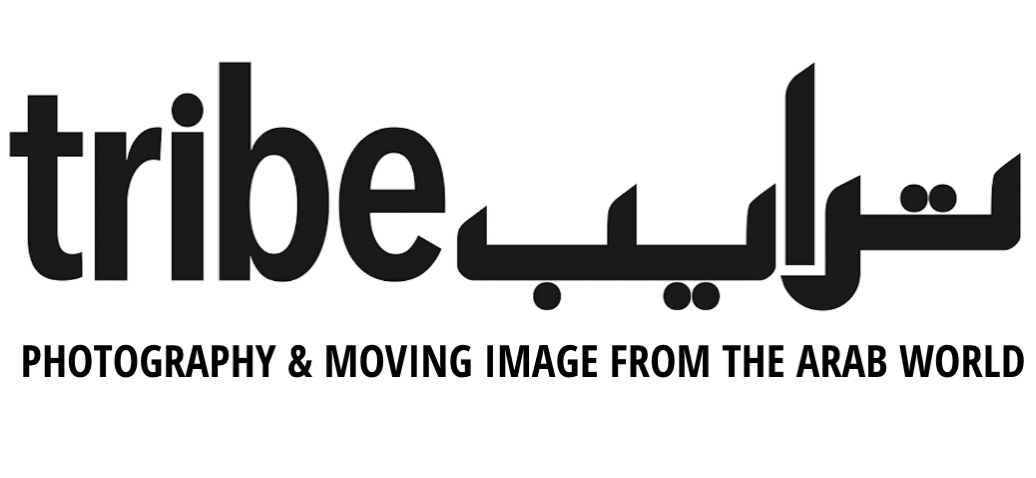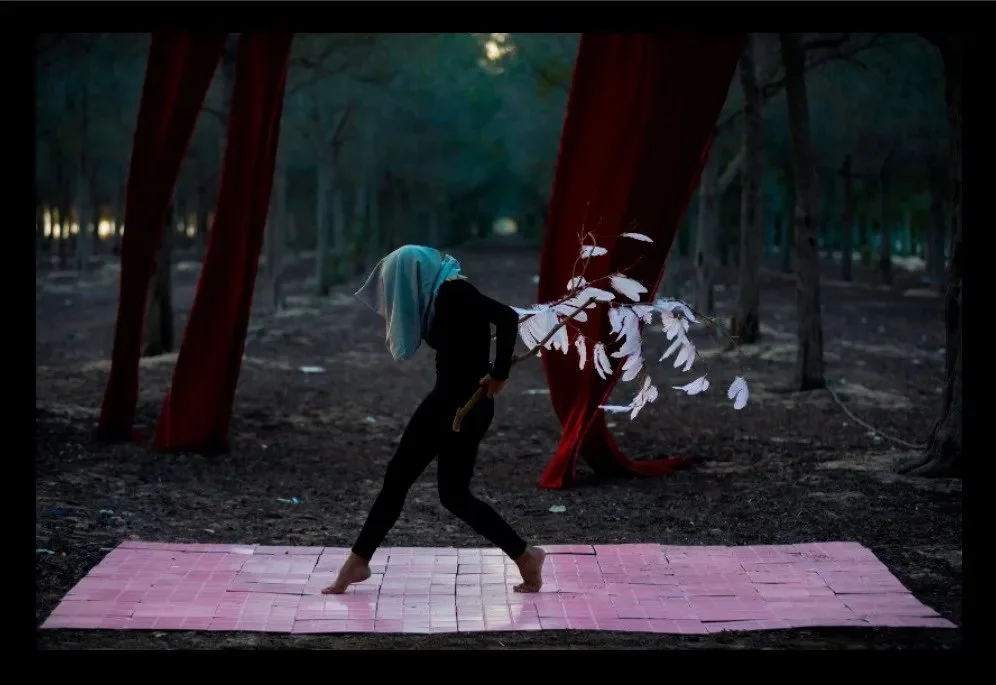Maitha Abdalla
Run with the Wolves
Hijacking theatrical codes in order to unpack life’s questions
Maitha Abdalla, installation at the Tabari Artspace booth, Abu Dhabi Art.
With text by Laura Cherrie Beaney social anthropologist, and author of Crossing the Catwalk: Transvestism in Contemporary Fashion and Culture with Academica Press, currently supports curatorial platform, Archaeology of the Final Decade (AOTFD), as a research assistant while pursuing a PhD at SOAS, University of London.
In order to untangle her internal struggles and pressing questions about the world, multidisciplinary artist Maitha Abdalla summons theatrical codes. In her scenes, one might encounter farm animals, regional folklore, or the bathroom mirror that captured adolescent transformation.
“After failed attempts to publish a novel, I found creative fuel in the visual language of art-house cinema,” says Abdalla. “I was deeply impacted by two films in particular. The damaged characters drowning in their dreams that I encountered in David Lynch’s Inland Empire (2006) and Sergei Parajanov’s The Colour of Pomegranates (1969), in which the mise en scène seems to blend theatre and painting.”
When she was a student Abdalla began to author her own cinematic scripts in order to escape the rigidity of the written word. This later transitioned into a focus upon theatrical methods of meaning- making. Abdalla created characters made from found objects such as wood and wire, coating them in plaster and in paint. They are animals and anthropomorphic beings deliberately left raw and frayed at the edges. As artist, director, actor, and subject matter, she established her own tableaux in order to enact moments from her past or current concerns. Her partially-biographical process not only helped her to make sense of her world but also to regain control over it.
“I wrote my own scenes based upon the visuals in my head,” says Abdalla. “I’d take the characters out, play with them, act with them and then keep them around me in my studio.”
Abdalla’s artistic practice crosses painting, film, sculpture, performance and photography often presented in dialogue to establish a theatrical setting, a recurrent motif in her practice. Abdalla is interested in conflating the contrived character of theatrical performance with that which cannot be easily articulated via the written or spoken word; memories, fantasies and dreams.
In Boudoir (2020) a performance video first presented at Abu Dhabi Art, for example, the viewer gazes into a shell of a building. Once a home, the space has been engulfed by the sand that seeps in from the surrounding desert. Inside, two young women perform a ritual, apparently unaware of their exposure to the audience through a paneless window. The performance is a metaphor for Abdalla’s preoccupation with the notion that cultural beliefs might dictate behaviour in harsh environments. Her setting resembles a stage set and betrays a trace of Lynch’s influence, each prop and character is invested with meaning. Here, a rooster and a pig, two icons that regularly appear in Abdalla’s practice are the embodiment of purity and sin and the materialisation of the folkloric tales that Abdalla’s grandmother recounted:
“Whenever you hear a rooster, there are angels nearby, and you can ask God for forgiveness.”
The UAE’s folklore has largely been passed from generation to generation verbally. Abdalla, however, solidifies these stories in her scenes and combines them with her lived experience. In Scars by Daylight (2021)—a body of work that combines photography, installation and painting—Abdalla considered the faith-based beliefs surrounding sin/purity that informed her youth in relation to her personal experience of adolescence. This work was seen in exhibitions at both Tabari Artspace, Dubai and at Cromwell Place, London. In one photograph, Allure (2020) a cluster of chickens follow Abdalla inside a bathroom. Artificial lighting reflects from ceramic tiles in a sickly ‘Palm Springs’ huge. The artist is dressed in a crudely constructed pig’s head and the patterned gown often worn by young Emirati women before they reach maturity:
“The bathroom is a space where rituals of purification and self-reflection take place and where the idea of adolescent transformation is most heavily pronounced with the body laid bare before the mirror,” says Abdalla.
Maitha Abdalla, Flying Closer to The Sun (2021)
Abdalla presented her most recent body of work, Too Close To The Sun (2021) at Abu Dhabi Art in November 2021. The series negotiates what the artist perceives to be the ‘wild nature’ of women that social forces have often attempted to tame. In ancient mythology the ‘wild woman’ was characterised as half-human, half-beast, covered in hair or vegetation, and living in the ‘wild’ or wilderness, away from ‘civilizing’ influences. In the series, Abdalla mines the perspectives of American Psychoanalyst, Clarissa Pinkola Estes, who asserts in Women Who Run with the Wolves that:
“Within every woman, there is a wild and natural creature, a powerful force, filled with good instincts, passionate creativity, and ageless knowing. Her name is Wild Woman, but she is an endangered species.”
Here, Abdalla returns to folklore relayed to her during her youth; reflecting upon Sila, the tale of a hybrid woman that listened to her wild spirit and left her family behind after she saw lightning in the sky, interpreting it as a sign to return to her clan in the wild. In Abdalla’s video performance by the same name the deterioration of her feathered wings echoes the myth of Icarus and the idea that if someone ‘flies too high’ they might get burned.
While Abdalla’s art tackles topics that might relate to an audience at a gendered, ethnic or cultural level she insists that she speaks from a deeply intimate and subjective space. To this end, she often places herself into her work either through personal performance, where her body connects visibly to her imaginings or through the characters that she constructs that are vessels for particular fragments of her persona:
“My work is my diary,” says Abdalla. “Me scenes help me to make sense of and divulge different aspects of myself. I can imagine how relatable I can be to females both within and beyond my culture. I think the subjects that I reflect on - sin/ forgiveness, right/wrong - are felt and considered by men and women universally. I was once asked why there are so many female figures in my work. It’s because I am a woman and I see myself in every character that I present, sometimes they are genderless, but in the end, they are all elements of myself. There is both the pig and the rooster in me.”
Maitha Abdalla is a challenging artist who works across artistic disciplines; melding and transforming both techniques and imaginaries. Her blending of performance and plastic arts is, in particular, highly innovative and brings together mediums and practices that are often held separately. Her imagination also plumbs subliminal depths, drawing upon myths that have their origins in ancient and medieval folklore but which have come to have new meaning for women seeking to extricate themselves from gendered stereotypes and embrace freer, wilder and marginal imaginings.
Maitha Abdalla, Between Daydreams and Nightmares (2020), Allure (2020), and The Beguiled Space (2020).






